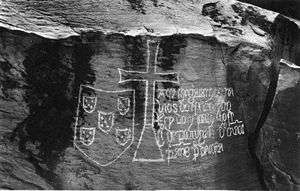Diogo Cão
| Diogo Cão | |
|---|---|
 | |
| Born |
ca. 1452 Vila Real, Kingdom of Portugal |
| Died | ca. 1486 |
| Nationality | Portuguese |
| Occupation | Navigator and explorer |
| Known for | First European to explore the Congo River and the west coast of Africa. |
Diogo Cão (Portuguese pronunciation: [diˈoɣu ˈkɐ̃w̃]), anglicised as Diogo Cam and also known as Diego Cam,[1] was a Portuguese explorer and one of the most notable navigators of the Age of Discovery. He made two voyages sailing along the west coast of Africa in the 1480s, exploring the Congo River and the coasts of the present-day Angola and Namibia.[2]
Early life and family

Cão was born in Vila Real (some say in Évora), in the middle of the 15th century, ca. 1452, the illegitimate son of Álvaro Fernandes or Gonçalves Cão, fidalgo of the Royal Household, himself the illegitimate son of Gonçalo Cão. He married and had four children: Pedro Cão, Manuel Cão, André Afonso Cão, and Isabel Cão.
Explorer

He was the first European known to sight and enter the Congo River and to explore the West African coast between Cape St. Catherine and Cape Cross, almost from the equator to Walvis Bay in Namibia.[3]
First voyage
When King John II of Portugal revived the work of Henry the Navigator, he sent out Cão (probably about midsummer 1482) to open up the African coast still further beyond the equator. The mouth and estuary of the Congo had been discovered (perhaps in August 1482) and marked by a Padrão, or stone pillar (still existing, but only in fragments), erected on Shark Point, attesting to the sovereignty of Portugal; the great river was also ascended for a short distance, and intercourse was opened with the natives of the Bakongo kingdom. Cão then coasted down along the present Angola (Portuguese West Africa), and erected a second pillar, probably marking the termination of this voyage, at Cape Saint Mary (the Monte Negro of these first visitors). He certainly returned to Lisbon by the beginning of April 1484, when John II ennobled him, made him a cavaleiro (knight) of his household (he was already an escudeiro or esquire in the same), and granted him an annuity and a coat of arms (April 8, 1484 and April 14, 1484).[3] On his return he discovered the Island of Annobón.
Second voyage

That Cão, on his second voyage of 1484–1486, was accompanied by Martin Behaim (as alleged on the latter's Nuremberg globe of 1492) is very doubtful. But it is known that the explorer revisited the Congo and erected two more pillars beyond the furthest of his previous voyage. The first was at another Monte Negro (now Cabo Negro, Angola), the second at Cape Cross. The Cape Cross pillar probably marked the end of his progress southward, some 1,400 kilometers.[3] Cão ascended the Kongo River (which he thought led towards the realm of Prester John), up to the neighborhood of the site of Matadi. There, in October or November, 1485, near the falls of Ielala, he left an inscription engraved on the stone which testifies of its passage and that of his men: Aqui chegaram os navios do esclarecido rei D.João II de Portugal - Diogo Cão, Pero Anes, Pero da Costa. ("Here arrived the ships of the enlightned king John II of Portugal – Diogo Cão, Pero Anes, Pero da Costa").
According to one authority (a legend on the 1489 map of Henricus Martellus Germanus), Cão died off Cape Cross; but João de Barros and others wrote of his return to the Kongo, and subsequent taking of a native envoy to Portugal. The four pillars set up by Cão on his two voyages have all been discovered in situ, and the inscriptions on two of them from Cape Santa Maria and Cape Cross, dated 1482 and 1485 respectively, are still to be read and have been printed. The Cape Cross padrão is now at Berlin (replaced on the spot by a granite facsimile); those from the Kongo estuary and the more southerly Cape Santa Maria and Cabo Negro are in the Museum of the Lisbon Geographical Society.[3]
In literature
Diogo Cão is the subject of Padrão, one of the best-known poems in Fernando Pessoa's book Mensagem, the only one published during the author's lifetime. He also figures strongly in the 1996 novel Lord of the Kongo by Peter Forbath.
Sources
- Barros, João de. Décadas da Ásia, Década I. bk. III., esp. ch. 3;
- Ruy de Pina, Chronica d'el Rei D. João II.;
- Garcia de Resende, Chronica;
- Luciano Cordeiro, Diogo Cão in Boletim da Sociedade de Geografia de Lisboa, 1892;
- E; G. Ravenstein, Voyages of Diogo Cão, &c., in Geog. Jnl. vol. xvi. (1900), also Geog. Jnl. xxxi. (1908).
- António da Costa de Albuquerque de Sousa Lara, 2nd Count de Guedes, Vasco de Bettencourt de Faria Machado e Sampaio and Marcelo Olavo Correia de Azevedo, Ascendências Reais de Sua Alteza Real a Senhora Dona Isabel de Herédia Duquesa de Bragança, I, pelos Costados Herédia, Bettencourt e Meneses da Ilha da Madeira" (Universitária Editora, 1999)
See also
External links
References
- ↑ "Angola", Encyclopædia Britannica, 9th ed., Vol. II, New York: Charles Scribner's Sons, 1878, p. 45.
- ↑ Chisholm 1911.
- 1 2 3 4
 One or more of the preceding sentences incorporates text from a publication now in the public domain: Beazley, C. Raymond (1911). "Cam (Cão), Diogo". In Chisholm, Hugh. Encyclopædia Britannica. 5 (11th ed.). Cambridge University Press. p. 79.
One or more of the preceding sentences incorporates text from a publication now in the public domain: Beazley, C. Raymond (1911). "Cam (Cão), Diogo". In Chisholm, Hugh. Encyclopædia Britannica. 5 (11th ed.). Cambridge University Press. p. 79.